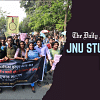Climate change is fuelling child marriage in Bangladesh

"We raise awareness on the negative consequences of child marriage in the community and have stopped a few child marriage cases," said a girl student of Class 8 during one of my visits to a char in Kurigram. There were 30 students when they started school, but around half were no longer with them. Why? Families of those students moved to other areas due to river erosion. Some were able to continue while many students were at the risk of dropping out. I wondered how this was affecting girls' education, as they already face so many challenges.
Although secondary school enrolment in Bangladesh has increased over the last decade, girls are still dropping out and failing to learn the skills they need. Most girls in rural Bangladesh drop out after primary school. The gross enrolment rate of female students at the secondary level was 83.20 percent, the dropout rate was 40.78 percent, and the completion rate was 59.22 percent in 2022, according to the Bangladesh Bureau of Educational Information and Statistics (BANBEIS). Evidence suggests that families continue to invest more in secondary education for boys, while girls are more likely to be involved in household activities, which leads to school absences, poorer academic outcomes, and higher dropout rates.
Child marriage—a serious violation of children's rights and a form of sexual violence—is one of the major reasons behind adolescent girls dropping out of school. Girls who are forced to marry early have increased health problems and face more domestic violence. Sustainable Development Goal (SDG) target 5.3 aims to eliminate child marriage by 2030, but that goal seems unachievable by international organisations due to the rise in child marriage since the Covid pandemic.
According to Unicef, Bangladesh has the highest prevalence of child marriage in South Asia and ranks among the 10 countries in the world with the highest rates of child marriage. About 51 percent of women currently aged 20-24 were married while they were still children, according to "Ending Child Marriage: A Profile of Progress in Bangladesh 2020."
In Bangladesh, child marriage usually means the end of schooling for girls, as many adolescent girls become mothers immediately after marriage, and they face barriers from their families, schools, and society against returning to school. Poverty, lack of social safety for adolescent girls, natural disasters, and weak enforcement of the Child Marriage Restraint Act of 2017 are some of the reasons behind the prevalence of child marriage.
The climate crisis is making girls' lives harder in different parts of the world. It destroys homes and livelihoods, driving children and their families further into poverty. And when families struggle, it is girls who tend to lose out. The combination of climate risks and child marriage has created emergency hotspots for girls' rights. And Bangladesh is among the top 10 hotspots, according to Global Girlhood Report 2023 by Save the Children.
There is limited data on the impact of climate change on child marriage in Bangladesh. However media reports suggest that it is already happening, as many families are internally displaced as a result of disasters and are struggling for their livelihoods.
Bangladesh is highly vulnerable to climate shocks, which disproportionately impact girls' ability to go to school, especially in vulnerable geographic areas like char, haor, and coastal areas where climate events pose the greatest threat. Floods, tropical cyclones, storm surges, and droughts are likely to become more frequent and severe in the coming years due to climate change. The signs of future changes have already begun to become apparent: the frequency of disasters has increased and their patterns have changed, which has increased uncertainties for parents, making girls more vulnerable.
In Bangladesh, the incidence of child marriage begins to decline only among those with at least 10 years of schooling, and its prevalence falls below 50 percent among those with at least 12 years of schooling. It is, therefore, extremely important that girls stay at school.
Climate change adaptation programmes must support efforts that promote greater access to quality education for adolescent girls. There is a need to develop and implement flexible, accessible, inclusive, and gender-responsive distance learning programmes that can be scaled up rapidly in the event of future school closures to prevent disruptions to learning. In the longer term, construction or improvement of education facilities should draw on the Inter-Agency Network for Education in Emergencies Guidance on Safer School Construction to make schools more resilient to disasters and shocks.
Targeted initiatives should be taken by the government to protect and support the incomes of families with girl children, including social protection interventions such as cash transfers, to reduce the risk of child marriage as an economic coping strategy.
Properly enforcing the law against child marriage, strengthening the child protection system, ensuring girls' safety in the communities, increasing parental awareness on the rights of girls to education, health, and protection, and launching a campaign to make child marriage socially unacceptable will also contribute to preventing child marriage. It is critical to incorporate the views of girls in climate change adaptation decision-making and risk reduction activities and consider their priorities in all decisions affecting their well-being.
Girls in Bangladesh want to continue their education and contribute to the economy and society. We must be proactive in ensuring that they don't become more vulnerable due to climate change. The government, civil society, media, parents, and all community members must perform their responsibilities more effectively to ensure that our girls can dream freely and realise their potential to the fullest.
Laila Khondkar is an international development worker.
Views expressed in this article are the author's own.
Follow The Daily Star Opinion on Facebook for the latest opinions, commentaries and analyses by experts and professionals. To contribute your article or letter to The Daily Star Opinion, see our guidelines for submission.


 For all latest news, follow The Daily Star's Google News channel.
For all latest news, follow The Daily Star's Google News channel. 










Comments